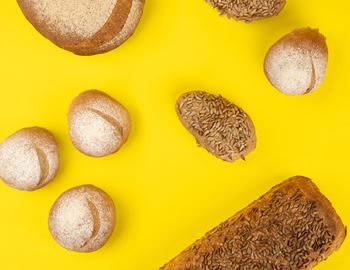Recipe for bread and rolls from the Norwegian cooking teams.
This is what you need
- 1500 g Cold water
- 1000 g Collected fine wheat
- 140 g Collected fine rye
- 860 g Wheat flour
- 40 g Fresh yeast
- 30 g Salt
How to do it:
- Mix together cold water and the flour. Tip! Let the water and flour mixture sit on the counter for an hour and swell to make the pastry juicier.
- Then you add salt and yeast. Knead the dough in the Wilfa Probaker (with kneading hook) for approx. 10 minutes on low speed, and approx. 5 minutes on medium/fast speed. The dough is finished kneading when it is smooth and pliable - and you can stretch it out into a thin layer, without the dough breaking (gluten test).
- Put a cloth over the dough and let it rest for approx. 1 hour
- Divide the dough by weight into the bread and rolls listed in the points below. We will now make two types of bread and slightly different rolls.
Bread no. 1:
Weigh out 550 g of dough. Shape into a large bowl and place on baking paper. Place a cloth over the bread and let rise for 1-1.5 hours. Set the oven on hot air and at the highest possible temperature. Insert a baking sheet at the same time (preferably a pizza stone if you have one) so that it also gets hot. Sprinkle sifted flour over the bread. Use a sharp knife, preferably a paring knife or razor blade, and make cuts on top of the bread, in the middle of the bread. Or you can be a little creative and make your own pattern. Slicing the bread is not just for appearance, it is a way of controlling how the bread cracks when it rises in the oven during baking. Turn the oven down to 230 degrees and insert the bread, bake for approx. 30 min. Cool on a wire rack.
Bread no. 2:
Weigh out 750 g of dough. Shape into an oblong loaf. Roll in sunflower seeds and place in a loaf pan (If you don't have a loaf pan, the dough can be placed on baking paper on the baking tray). Place a cloth over it and let rise for 1-1.5 hours. Set the oven on hot air and at the highest possible temperature. Turn the oven down to 230 degrees before putting the bread in. Bake for approx. 30 min. Cool on a wire rack.The rest of the dough is shaped into rounds of approx. 90 grams. Feel free to dip the top in sunflower seeds or other seeds. Put on a tray with baking paper. Cover with cloth and proof for 45-60 min. Alternatively, you can sift some flour on top of the rolls, preferably with a stencil if you have one. Bake at 230 degrees in hot air for 10-15 minutes. Cool on a wire rack.
If you have not dipped the rolls in sunflower seeds, you can sift some flour, preferably use a stencil. If you do not use a stencil, it can be nice to decorate the rolls with something of your own.
Hacks
- Get juicier baking! Before you start baking, mix together cold water and the flour mixture. Leave the mixture on the counter for one hour and swell to make the cake juicier.
- By using less yeast, you get a longer rising time and then you get a better taste.
- If you want fresh baking for several days, you can put parts of the dough in a tight box in the fridge. Bread should be made on day 1 or 2 after the dough is made, after that rolls are recommended.
- When kneading a dough, make sure it does not exceed 26 degrees. If it gets warmer, the yeast can die.
- Gluten test: When the dough has become smooth and pliable, take a gluten test to check whether the gluten in the flour has fully developed. Put water on your fingers so the dough doesn't stick. Pull the dough out between your fingers. When you can pull out a thin transparent membrane, a bit like chewing gum, the dough is finished kneading. If it feels short and cracks when you pull it, knead a little more.
Please start with a little too little water, then add a little extra if necessary. This will ensure an even gluten development.
If the dough seems a little dry and the seeds/cores won't stick, it may be a good idea to either roll the dough over a damp cloth first or spray with a little water.
Slicing - for a finer result and avoid cracks in the crust. When the loaves have finished rising, you should slice them. Slitting gives the gas a place to escape
Baking tip:
When you have inserted the loaves. Place an ovenproof dish or similar in the bottom of the oven with a couple of dl of hot water at the bottom of the oven. This will give the breads a crispier crust. Remove the water after approx. 10 min.
Or spray the loaves/rolls with water, it will also give a crispier crust.

